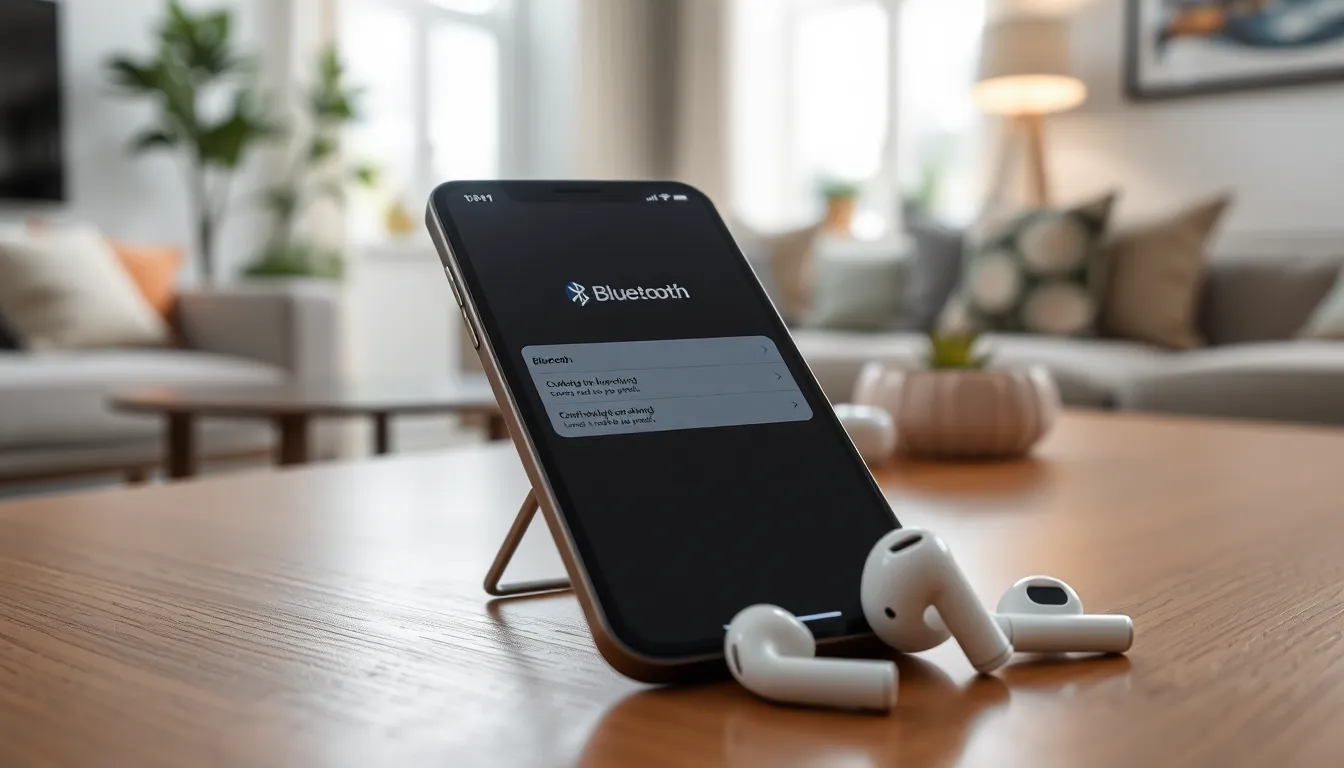Table of Contents
TogglePicture this: you’re ready to dive into your favorite playlist or catch up on that podcast everyone’s raving about. You grab your AirPods, pop them in, and—surprise!—they refuse to connect to your iPhone. It’s like they’re playing hard to get. Frustrating, right?
Common Connection Issues
Connection problems with AirPods may arise for several reasons, often leading to user frustration. Understanding the potential culprits helps in troubleshooting connectivity.
Bluetooth Settings
Bluetooth settings often require checking when AirPods fail to connect. Ensure Bluetooth is enabled on the iPhone, as this basic step can resolve many connection issues. Disabling and then enabling Bluetooth may help refresh the connection. The iPhone should also be near the AirPods during pairing. If multiple devices are connected, disconnect non-essential devices to reduce interference.
AirPods Compatibility
AirPods compatibility plays a crucial role in connection issues. AirPods generally work well with iPhones released from 2016 onward. Users should verify their iPhone’s iOS version, which should be at least iOS 10 for initial compatibility. Older iPhones may experience connectivity limitations with newer AirPods versions. Checking for firmware updates can also improve connection performance.
Troubleshooting Steps

When AirPods won’t connect to an iPhone, a few troubleshooting steps can resolve the issue.
Restarting Devices
Restarting both the iPhone and AirPods often fixes connectivity problems. To restart the iPhone, press and hold the power button until the slider appears, then slide to power off. AirPods can be restarted by placing them in the charging case and closing the lid for about 15 seconds. This simple action refreshes the Bluetooth connection. After restarting, users should attempt to connect the AirPods again.
Resetting AirPods
Resetting the AirPods can restore factory settings, which sometimes resolve issues. Users should place the AirPods in their charging case, close the lid, then wait for 30 seconds. Opening the lid again prompts the user to press and hold the button on the back until the status light flashes amber and then white. This reset erases previous connections. After this process, they can reconnect the AirPods by selecting them from the Bluetooth settings on the iPhone.
Forgetting and Reconnecting
Forgetting the AirPods and reconnecting can address lingering connection problems. To do this, the user must navigate to Bluetooth settings, locate the AirPods in the list, and select “Forget This Device.” After confirming the action, users can reconnect by putting the AirPods in pairing mode and choosing them from the Bluetooth list on the iPhone. This method often resolves persistent connectivity issues.
Software and Updates
Software and updates play a crucial role in ensuring seamless connectivity between AirPods and iPhones.
iOS Updates
iOS updates frequently include enhancements that improve device performance and resolve bugs. Updating to the latest iOS version often helps AirPods connect more reliably. Users should check their iPhone settings by navigating to General, then selecting Software Update to see available updates. Installing updates ensures compatibility with AirPods, reducing connectivity issues. It’s essential to keep the iPhone’s operating system current for optimal performance.
AirPods Firmware
AirPods also require firmware updates for peak functionality. These updates can fix bugs and improve overall stability. Users can check firmware versions by connecting AirPods to their iPhone and accessing Settings, then Bluetooth, and tapping the information icon next to the AirPods name. Automatic updates typically occur when AirPods are charging and connected to the iPhone via Bluetooth. Keeping the firmware up to date results in better performance and fewer connection problems.
Environmental Factors
Environmental factors can significantly affect the Bluetooth connection between AirPods and an iPhone.
Distance and Obstructions
Distance plays a pivotal role in connectivity. Keeping the AirPods within a reasonable range of the iPhone optimizes the connection. Obstacles such as walls, furniture, or other objects can hinder the Bluetooth signal. Users should maintain a clear line of sight whenever possible to prevent potential disconnects. Moving too far away from the iPhone results in audio dropouts and connection failure. Ensuring proximity improves overall performance and reduces frustration during use.
Interference from Other Devices
Interference from electronic devices causes connection issues. Bluetooth operates on a 2.4 GHz frequency, and devices like Wi-Fi routers and microwaves can disrupt the signal. Turning off nearby devices may enhance connectivity for AirPods. Users can also adjust settings on their router to reduce congestion on the 2.4 GHz band. Additionally, crowded areas with many Bluetooth devices impact connectivity as well. Being aware of these interference sources enables a smoother pairing experience.
Resolving AirPods connection issues with an iPhone can be straightforward with the right approach. Users should focus on ensuring Bluetooth is enabled and that both devices are up to date. Restarting the devices and resetting the AirPods can often clear up persistent problems.
It’s essential to consider environmental factors that might interfere with the Bluetooth signal. Keeping devices close and minimizing obstructions can enhance connectivity. By following these tips and troubleshooting steps, users can enjoy a seamless listening experience with their AirPods.




